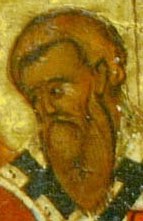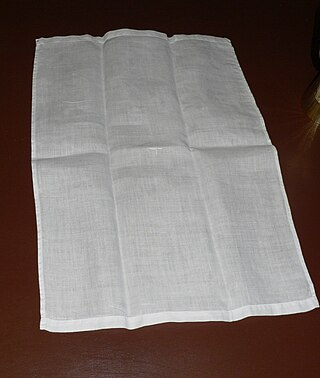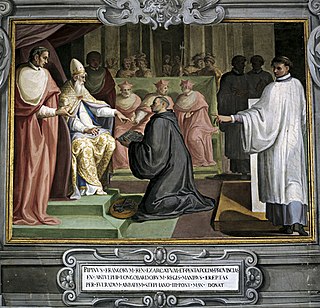Related Research Articles
Primate is a title or rank bestowed on some important archbishops in certain Christian churches. Depending on the particular tradition, it can denote either jurisdictional authority or (usually) ceremonial precedence.
Abbé is the French word for an abbot. It is also the title used for lower-ranking Catholic clergy in France who are not members of religious orders.
JohannesBusch was a major reformer and provost of a community of Canons Regular. He was associated with the Brethren of the Common Life.
In a number of Christian traditions, including Orthodoxy, Catholicism, Lutheranism, and Anglicanism, a confessor is a priest who hears the confessions of penitents and pronounces absolution.

Epiphania or Epiphaneia was a city in Cilicia Secunda, in Anatolia.

Pudens was an early Christian saint and martyr.
Paltus or Paltos is a ruined city. It was also a bishopric, a suffragan of Seleucia Pieria in the Roman province of Syria Prima, that, no longer being a residential see, is included in the Catholic Church's list of titular sees. The ruins of Paltus may be seen at Belde at the south of Nahr al-Sin or Nahr al-Melek, the ancient Badan.
Regionarius, plural Regionarii, is the title given in later Antiquity and the early Middle Ages to those clerics and officials of the Church of Rome who were attached neither to the Papal Palace or patriarchium, nor to the titular churches of Rome, but to whom one of the city regions, or wards, was assigned as their official district.
Danaba was a town and bishopric in the late Roman province of Phoenicia Secunda.

Lete was an ancient city in Mygdonia, Macedon and Roman Catholic titular see in the Roman province of Macedonia.

A chrismarium, chrismal, or chrismatory is a container for holy oils, considered a sacramental in the Catholic Church.

Manuterge is the name given by the Roman Catholic Church to the towel used by the priest when engaged liturgically.
Motella, Metello(u)polis, or Pulcherianopolis was a city in the Roman province of Phrygia Pacatiana, in Asia Minor, probably on the site of the modern Yeşiloba (Medele).
Eucarpia or Eukarpia was a city in Phrygia and a bishopric in the late Roman province of Phrygia Salutaris, in Asia Minor.
Thomas Atkinson was an English Roman Catholic priest. He is a Catholic martyr, beatified in 1987.

Papal appointment was a medieval method of selecting the Pope. Popes have always been selected by a council of Church fathers; however, Papal selection before 1059 was often characterized by confirmation or nomination by secular European rulers or by the preceding pope. The later procedures of the Papal conclave are in large part designed to prohibit interference of secular rulers, which to some extent characterized the first millennium of the Roman Catholic Church, e. g. in practices such as the creation of crown-cardinals and the claimed but invalid jus exclusivae. Appointment may have taken several forms, with a variety of roles for the laity and civic leaders, Byzantine and Germanic emperors, and noble Roman families. The role of the election vis-a-vis the general population and the clergy was prone to vary considerably, with a nomination carrying weight that ranged from nearly determinative to merely suggestive, or as ratification of a concluded election.
The numbering of "Popes John" does not occur in strict numerical order. Although there have been twenty-one legitimate popes named John, the numbering has reached XXIII because of two clerical errors that were introduced in the Middle Ages: first, antipope John XVI was kept in the numbering sequence instead of being removed; then, the number XX was skipped because Pope John XXI counted John XIV twice.

From 756 to 857, the papacy shifted from the influence of the Byzantine Empire to that of the kings of the Franks. Pepin the Short, Charlemagne, and Louis the Pious had considerable influence in the selection and administration of popes. The "Donation of Pepin" (756) ratified a new period of papal rule in central Italy, which became known as the Papal States.
The Synod of Milan or Council of Milan may refer to any of several synods which occurred in late Roman Mediolanum or medieval Milan in northern Italy's Po valley:

The Diocese of Castabala is a titular see in Turkey.
References
- Attribution
 This article incorporates text from a publication now in the public domain : Herbermann, Charles, ed. (1913). "Petinessus". Catholic Encyclopedia . New York: Robert Appleton Company.
This article incorporates text from a publication now in the public domain : Herbermann, Charles, ed. (1913). "Petinessus". Catholic Encyclopedia . New York: Robert Appleton Company.